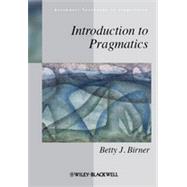
Introduction to Pragmatics
by Birner, Betty J.-

Receive Free Shipping To The More Store!*
*Marketplace items do not qualify for the free shipping promotion.
-
 We Buy This Book Back!
We Buy This Book Back!
-
 eCampus.com Device Compatibility Matrix
eCampus.com Device Compatibility Matrix
Click the device icon to install or view instructions
Buy New
Buy Used
Rent Textbook
Rent Digital
How Marketplace Works:
- This item is offered by an independent seller and not shipped from our warehouse
- Item details like edition and cover design may differ from our description; see seller's comments before ordering.
- Sellers much confirm and ship within two business days; otherwise, the order will be cancelled and refunded.
- Marketplace purchases cannot be returned to eCampus.com. Contact the seller directly for inquiries; if no response within two days, contact customer service.
- Additional shipping costs apply to Marketplace purchases. Review shipping costs at checkout.
Summary
Author Biography
Betty J. Birner is Professor of Linguistics in the Department of English at Northern Illinois University. She is the author of several books, including The Discourse Function of Inversion in English (1996), Information Status and Noncanonical Word Order in English (with Gregory Ward, 1998), and Drawing the Boundaries of Meaning: Neo-Gricean Studies in Pragmatics and Semantics in Honor of Laurence R. Horn (with Gregory Ward, 2006).
Table of Contents
Acknowledgments xii
1 Defining Pragmatics 1
1.1 Pragmatics and Natural Language 2
1.2 The Boundary Between Semantics and Pragmatics 9
1.3 Summary 34
1.4 Exercises and Discussion Questions 36
2 Gricean Implicature 40
2.1 The Cooperative Principle 41
2.2 Types of Implicature 62
2.3 Testing for Implicature 68
2.4 The Gricean Model of Meaning 73
2.5 Summary 74
2.6 Exercises and Discussion Questions 75
3 Later Approaches to Implicature 77
3.1 Neo-Gricean Theory 77
3.2 Relevance Theory 91
3.3 Comparing Neo-Gricean Theory and Relevance Theory 98
3.4 Summary 107
3.5 Exercises and Discussion Questions 108
4 Reference 110
4.1 Referring Expressions 110
4.2 Deixis 114
4.3 Defi niteness and Indefi niteness 121
4.4 Anaphora 130
4.5 Referential and Attributive Uses of Defi nite Descriptions 138
4.6 Summary 142
4.7 Exercises and Discussion Questions 143
5 Presupposition 146
5.1 Presupposition, Negation, and Entailment 146
5.2 Presupposition Triggers 152
5.3 The Projection Problem 155
5.4 Defeasibility 157
5.5 Presupposition as Common Ground 163
5.6 Accommodation 167
5.7 Summary 172
5.8 Exercises and Discussion Questions 173
6 Speech Acts 175
6.1 Performative Utterances 175
6.2 Felicity Conditions 183
6.3 Locutionary Acts 186
6.4 Direct and Indirect Speech Acts 191
6.5 Face and Politeness 200
6.6 Joint Acts 202
6.7 Summary 203
6.8 Exercises and Discussion Questions 204
7 Information Structure 207
7.1 Topic and Focus 210
7.2 Open Propositions 215
7.3 Discourse-Status and Hearer-Status 217
7.4 Information Structure and Constituent Order 219
7.5 Functional Compositionality 229
7.6 Summary 235
7.7 Exercises and Discussion Questions 236
8 Inferential Relations 241
8.1 Inferential Relations at the Constituent Level 243
8.2 Inferential Relations at the Propositional Level 260
8.3 Summary 268
8.4 Exercises and Discussion Questions 269
9 Dynamic Semantics and the Representation of Discourse 271
9.1 Theoretical Background 272
9.2 Static vs. Dynamic Approaches to Meaning 276
9.3 Discourse Representation Theory 278
9.4 The Scope of DRT and the Domain of Pragmatics 284
9.5 Summary 290
9.6 Exercises and Discussion Questions 291
10 Conclusion 293
10.1 The Semantics/Pragmatics Boundary Revisited 294
10.2 Pragmatics in the Real World 296
10.3 Pragmatics and the Future of Linguistic Theory 302
10.4 Summary 304
10.5 Exercises and Discussion Questions 304
References 306
Sources for Examples 314
Index 318
An electronic version of this book is available through VitalSource.
This book is viewable on PC, Mac, iPhone, iPad, iPod Touch, and most smartphones.
By purchasing, you will be able to view this book online, as well as download it, for the chosen number of days.
Digital License
You are licensing a digital product for a set duration. Durations are set forth in the product description, with "Lifetime" typically meaning five (5) years of online access and permanent download to a supported device. All licenses are non-transferable.
More details can be found here.
A downloadable version of this book is available through the eCampus Reader or compatible Adobe readers.
Applications are available on iOS, Android, PC, Mac, and Windows Mobile platforms.
Please view the compatibility matrix prior to purchase.

